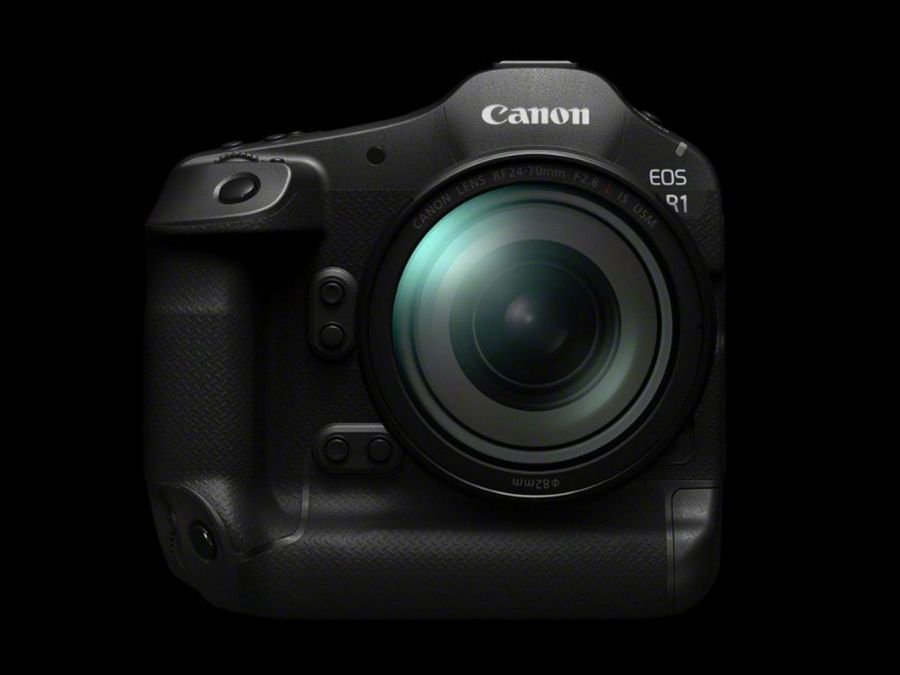Canon says it’s developing the Canon EOS R1 – a flagship mirrorless EOS R system camera for professional sports photographers. The firm is not giving away many concrete details at this point – for example, we don’t even know the sensor resolution yet. But what we do know so far suggests that, unsurprisingly, the EOS R1 is designed to be a step above the three-year-old EOS R3 as the best Canon mirrorless camera yet, doubtless promising the company’s fastest shooting and most advanced subject detection autofocus.
Expectations are high, as we’ve been waiting for this camera for a long time. Canon traditionally revealed its EOS-1D X series professional DSLRs on a four-year cycle, with each model appearing at the start of an Olympics year. In effect, the EOS R1 is the successor to the EOS-1D X Mark III from 2020, and like many other industry observers, we were expecting it to appear in January or February.
Canon’s press release is deliberately vague, talking of a new DIGIC Accelerator processor and touting such things as “never-before-seen advancements in Auto Focus”. For example, a new AF “Action Priority” mode promises to automatically identify and shift focus onto the main subject in a complex sporting situation. In terms of design, Canon’s teaser image shows a dual-gripped body that looks much like the existing EOS R3.
For full details see Canon’s press release below, but here are some selected claims about the EOS R1:
- ‘combines top-class performance with the strong durability and high reliability’
- ‘dramatically improves the performance of both still images and video (in comparison to the EOS R3)’
- ’employs the newly developed image processor DIGIC Accelerator in addition to the pre-existing processor DIGIC X’
- ‘delivers never-before-seen advancements in Auto Focus and other functions’
- ‘Canon has achieved high-speed and high-accuracy subject recognition’
Everything else is speculation at this point, but other features we might possibly see include:
- Quad-pixel phase detection autofocus, capable of detecting both horizontal and vertical details
- Eye-control focus, updated from the EOS R3
- Ultra-high-speed continuous shooting
- 4K 120p video recording
- Canon’s best electronic viewfinder experience to date
- Super-fast connectivity for pro sports shooters, both wired and wireless
Whatever the Canon EOS R1 ends up looking like, it’ll have its work cut out to compete with the likes of the Nikon Z9 and Nikon Z8. These are probably the finest pro-spec all-rounders we’ve tested, with a stunning blend of high resolution, breathtaking speed, superb handling and practically foolproof autofocus. And let’s not forget the Sony Alpha 9 III, with its ground-breaking global shutter technology, which is probably the most accomplished sports-specialist model that we’ve tested to date.
That said, we were also incredibly impressed by the Canon EOS R3‘s speed and autofocus, and in particular its eye-control focus. So the omens for the R1 are good. With the first of the summer’s major sporting events, UEFA EURO 2024 kicking off in mid-June, followed by the Paris 2024 Olympics a month later, hopefully it won’t be too long before we can see and test the Canon EOS R1 for real.
Follow AP on Facebook, Twitter, Instagram, YouTube and TikTok.
From Canon:
Canon develops EOS R1 as first flagship model for EOS R SYSTEM
New image processing system further improves AF and image quality
London, UK, 15 May 2024 – Canon Inc. announces today that it is currently developing the EOS R1, a full-frame mirrorless camera, as the first flagship model for the EOS R SYSTEM equipped with RF mount, launching in 2024.
The EOS R1 is a mirrorless camera geared toward professionals that brings together Canon’s cutting-edge technology and combines top-class performance with the strong durability and high reliability sought in a flagship model. This camera will dramatically improve the performance of both still images and video (in comparison to the EOS R3) and meet the high requirements of professionals on the frontlines of a wide range of fields including sports, news reporting, and video production.
This camera employs the newly developed image processor DIGIC Accelerator in addition to the pre-existing processor DIGIC X. The new image processing system, composed of these processors and a new CMOS sensor, enables a large volume of data to be processed at high speeds and delivers never-before-seen advancements in Auto Focus (AF) and other functions.
By combining the new image processing system and deep learning technology to an advanced degree, Canon has achieved high-speed and high-accuracy subject recognition. For example, subject tracking accuracy has been improved so that in team sporting events where multiple subjects intersect, the target subject can continually be tracked even if another player passes directly in front of them. In addition, the AF “Action Priority” function recognises subject movement by rapidly analysing the subject’s status. In moments during a sports game when it is difficult to predict what will happen next, this function automatically determines the player performing a certain action, such as shooting a ball, as the main subject and instantly shifts the AF frame, thereby helping to capture decisive moments of gameplay.
The combination of the new image processing system and deep learning technology will help to improve image quality. Canon implements the image noise reduction function, which has been previously developed and improved as part of the software for PCs, as a camera function to further improve image quality and contribute to user creativity.
Canon is working on field tests for this camera and will support capturing definitive and impactful moments at international sporting events to be held in the future.
Going forward, Canon will continue to expand the EOS R SYSTEM lineup of cameras and RF lenses, thereby continuing to meet the demands of a wide range of users and contribute to the development of photography and video culture.







